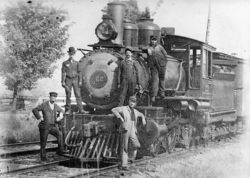Toronto, Hamilton and Buffalo Railway
| Toronto, Hamilton and Buffalo Railway | |
|---|---|
| logo | |
| Reporting marks | THB |
| Locale | Niagara Peninsula, Ontario |
| Dates of operation | 1892 – 1987 |
| Track gauge | 4 ft 8½ in (1435 mm) (standard gauge) |
| Headquarters | Hamilton, Ontario |
The Toronto, Hamilton and Buffalo Railway (TH&B; AAR reporting mark THB) was a railway based in Hamilton that ran in Southern Ontario from 1894 to 1987. It never reached the other two cities in its name, although it did have branch lines extending to Dunnville and Port Maitland.
History
The railway was originally chartered in 1884 by the Ontario Legislative Assembly to run from Toronto to the International Railway Bridge, connecting with local lines to Buffalo.The original charter forbade the company any attempt to merge with, lease from, sell to, or pool with any other railway. Given the business conditions at the time, this turned out to be an impossible condition. The original corporation was unable to complete the line before the original charter expired, so the government revived the act, requiring the line to be completed by 1894, with a new group of promoters.
It began operations in 1892, when it took over the incomplete line of the Brantford, Waterloo & Lake Erie Railway between Brantford and Waterford. The line reached Hamilton in October, 1894 and Welland on December 30, 1895.
In 1895, the Canadian Pacific Railway and the New York Central Railroad bought the TH&B.
The TH&B was jointly owned by the CPR and the NYC for several decades. NYC and its subsidiaries (Michigan Central Railroad and Canada Southern Railway) owned 73%, while the CPR owned the other 27%. It never built into Toronto or Buffalo, but used its parent companies' trackage to reach the two cities. Passenger service on the TH&B was discontinued on April 26, 1981. In 1977, CP Rail acquired NYC's portion (at that point part of the bankrupt Penn Central and destined not to be included in Conrail), and merged the TH&B into its system in 1987. While the TH&B line between Hamilton and Welland is still in use, its former line west of Hamilton to Waterford via Brantford has been abandoned past Aberdeen Avenue in Hamilton. The portion between Hamilton and Brantford was abandoned in the 1990s after trackage next to the Grand River was washed out. Some former TH&B industrial trackage still remains in the city of Brantford, although it is now operated by Canadian National Railway.
Increased operating costs, and tighter profit margins in that decade meant the future of the railroad was much in doubt. The TH&B Railway was merged into the Canadian Pacific Railway on January 1, 1987.
A portion of the branch of the former TH&B railroad (CP's Dunnville Spur, built by the TH&B in 1914), running from Smithville to Port Maitland via Dunnville, was abandoned on May 7, 2001, when the Port Maitland Turn made its final run between Smithville and E & O on that line. Trains were redirected onto the former NYC CASO subdivision, at Welland, to the remainder of the Dunnville spur, via a new connecting track.
Railway Stations
The TH&B's second railway station in Hamilton, built in 1933, was the only art deco station in Ontario. The station was refurbished in 1996 and is now used by GO Transit for both bus and train service.
The TH&B's Brantford station has been converted to use as a restaurant and has carried several names since the first one opened in 1970.
The TH&B's Smithville station, built 1903, was restored in 1996, and is now the headquarters of the West Lincoln Historical Society. It is open seasonally as a tourist information centre.
The TH&B's Jerseyville station is now at the Westfield Pioneer Village near Rockton, Ontario, along with preserved TH&B steam locomotive #103.
Diesel Locomotives
The TH&B was one of the first railways in Canada to fully dieselize. Starting in January 1948, the railway purchased of four NW2 diesel switchers from General Motors Electro-Motive Division. These locomotives were numbered 51-54. In the fall of 1950 the TH&B received an order for four GP7 road switchers built by GMDD in London. These GP7's were the first Canadian built "Geeps", and were numbered 71-74. In December of 1950 the TH&B took a second order from GMDD for four SW9 switchers. With its switcher fleet complete the TH&B looked to add to its freight Geeps. In the summer of 1953 the final three GP7's were purchased from GMDD, and numbered 75-77. Still needing to commit motive power to the locomotive pool for through Toronto-Buffalo passenger service, the TH&B purchased three GP9's. These three locomotives were delivered in early 1954, and numbered 401-403. This completed the railway's diesel fleet, and the TH&B did not purchase any new motive power for the remainder of its operating years.
External links
|
Current (operating) regional railways of Canada Former or fallen flag regional railways of Canada |
|
Current (operating) short line railways of Canada |
|
Former or fallen flag short line railways of Canada |

